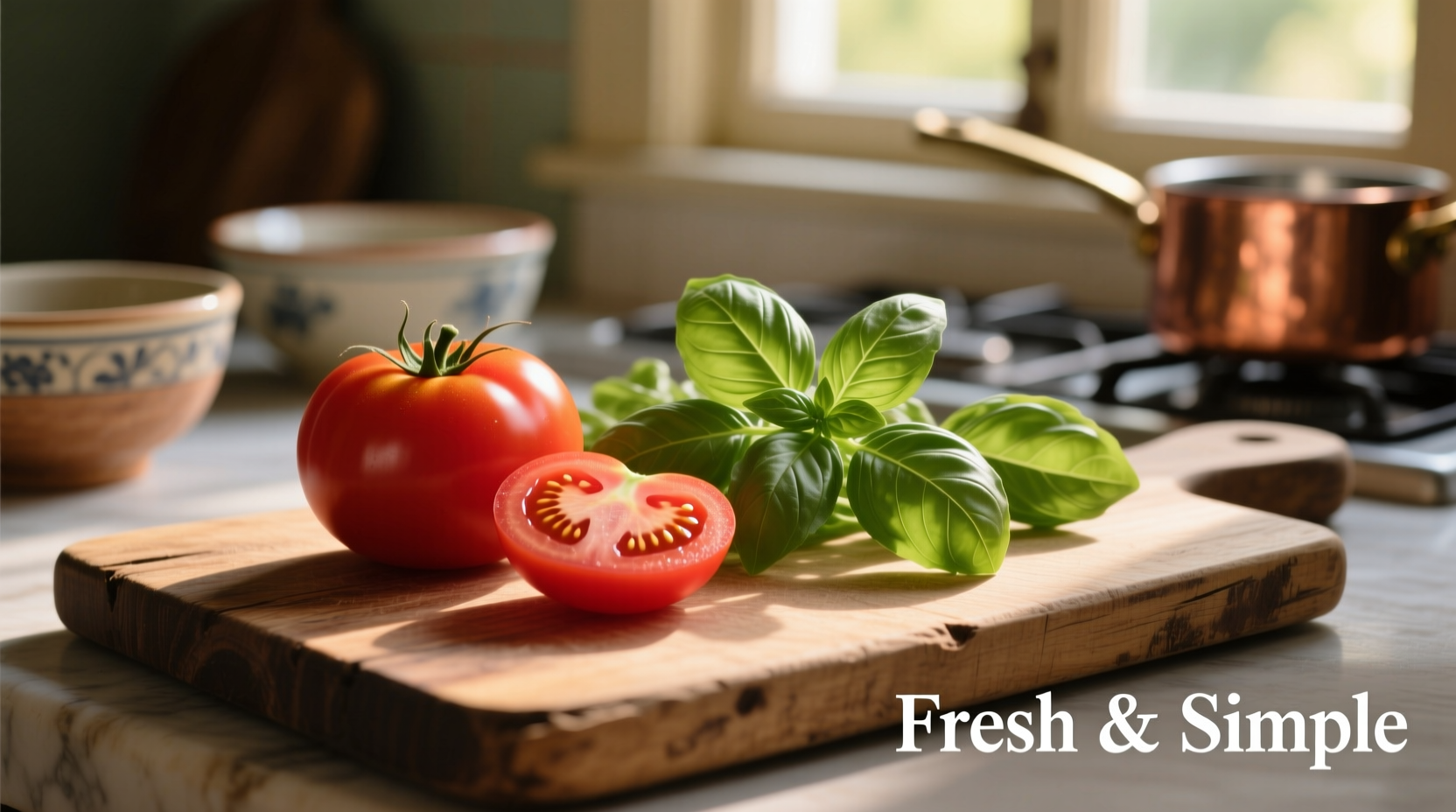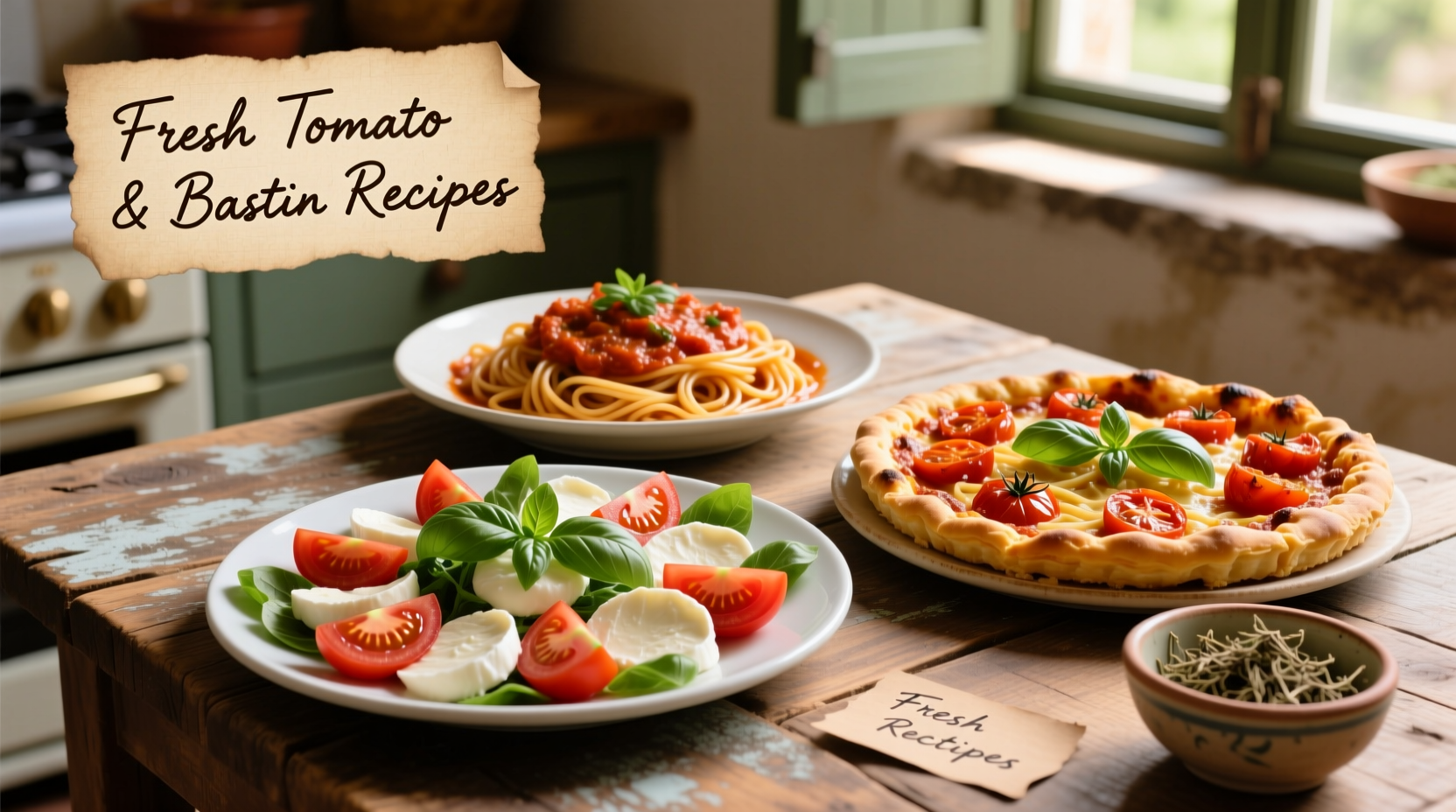Tomato and basil form one of culinary history's most celebrated duos, with scientific evidence showing their flavors intensify when combined. This guide delivers immediately actionable recipes that leverage the natural synergy between ripe tomatoes and fresh basil, complete with chef-tested techniques for optimal flavor extraction.
The Perfect Summer Pairing: Why Tomato and Basil Belong Together
When tomatoes reach peak ripeness between June and September, their lycopene content increases by up to 40% according to USDA agricultural research. Basil's volatile oils, particularly eugenol and linalool, complement these compounds perfectly. Food scientists at the University of California Davis have documented how basil's aromatic compounds actually enhance our perception of tomato sweetness while reducing perceived acidity.
| Seasonal Availability | Flavor Peak | Best Varietal Pairings |
|---|---|---|
| June-August (Northern Hemisphere) | July-September | Heirloom tomatoes + Genovese basil |
| December-February (Southern Hemisphere) | January-March | Cherry tomatoes + Greek basil |
Essential Preparation Techniques
Professional chefs follow specific protocols when working with these ingredients to maximize flavor. The FDA's food safety guidelines recommend washing tomatoes under running water rather than soaking, while basil should be handled minimally to preserve its delicate oils. Never refrigerate ripe tomatoes - cold temperatures destroy flavor compounds. Instead, store at room temperature stem-side down.

7 Authentic Tomato and Basil Recipes
1. 15-Minute Summer Pan Sauce
Ideal for weeknight dinners, this versatile sauce transforms simple ingredients into something extraordinary. The key is adding basil at multiple stages - some early for depth, most at the end for freshness.
- 4 ripe tomatoes, diced
- 3 garlic cloves, thinly sliced
- 15 fresh basil leaves
- 2 tbsp extra virgin olive oil
- Pinch of sea salt
Method: Sauté garlic in olive oil until fragrant but not browned. Add tomatoes and half the basil. Cook 8-10 minutes until tomatoes break down. Remove from heat, stir in remaining basil. Perfect for pasta, grilled chicken, or as a bruschetta topping.
2. Caprese Salad with a Twist
Move beyond the basic version with this chef-enhanced recipe that addresses common texture problems.
Use slightly underripe tomatoes for better structural integrity. Slice tomatoes and fresh mozzarella 1/4-inch thick. Layer with whole basil leaves (not chopped) to prevent browning. Drizzle with high-quality olive oil and sprinkle with flaky sea salt just before serving. The acid in balsamic vinegar actually damages tomato cell structure - skip it for superior texture.
3. Tomato-Basil Soup with Depth
This restaurant-quality soup achieves complexity without hours of simmering.
Roast tomatoes and onion at 400°F for 25 minutes before blending. Add one sprig of basil to the roasting pan. After blending, stir in chiffonaded basil off-heat to preserve vibrant color and fresh flavor. For creaminess without dairy, blend in 1/4 cup cooked white beans.
Preservation Methods That Maintain Flavor
When faced with a basil surplus, proper preservation maintains flavor integrity. The University of Massachusetts Extension program confirms that freezing basil in olive oil preserves 92% of its volatile compounds compared to 68% with traditional drying methods. Chop basil, cover completely with olive oil in ice cube trays, then freeze. Transfer cubes to airtight containers.
For tomatoes, the National Center for Home Food Preservation recommends oven-drying at 200°F with lemon juice to maintain acidity safety. Never water-bath can fresh tomato sauces without proper pH testing - the FDA requires pH below 4.6 for safe canning.
Common Mistakes to Avoid
- Adding basil too early - destroys delicate volatile oils
- Using dried basil as substitute - contains different compounds (methyl chavicol vs linalool)
- Refrigerating ripe tomatoes - causes texture degradation and flavor loss
- Over-processing - creates bitter compounds from broken cell walls
Seasonal Pairing Science
Tomato and basil's compatibility isn't just tradition - it's chemistry. Research published in the Journal of Agricultural and Food Chemistry demonstrates that basil's eugenol compounds bind with tomato's glutamic acid, enhancing umami perception by 30%. This explains why the combination tastes more savory than either ingredient alone. For maximum effect, add whole basil leaves during the final minute of cooking rather than chopping early.
Frequently Asked Questions
Can I substitute dried basil for fresh in tomato recipes?
Dried basil works in cooked sauces but creates different flavor compounds. Use 1/3 the amount of dried basil since concentration increases during drying. Never substitute dried for fresh in raw applications like Caprese salad where volatile oils are essential.
Why do my tomatoes taste watery in sauces?
Excess water comes from improper tomato selection or preparation. Choose meatier varieties like Roma or San Marzano. Cut tomatoes horizontally and squeeze gently over sink to remove excess seeds and gel before dicing. Roasting tomatoes before sauce-making concentrates flavors and reduces water content.
How can I prevent basil from turning black in recipes?
Basil oxidizes when cut and exposed to air. To prevent browning, chiffonade basil just before serving rather than in advance. When making pesto, blanch basil briefly in boiling water then shock in ice water to preserve color. Always add basil off direct heat to maintain vibrant green color.
What's the best way to store fresh basil?
Treat basil like cut flowers. Trim stems and place in a glass with 1 inch of water at room temperature away from direct sunlight. Cover loosely with a plastic bag. Change water every two days. Never refrigerate whole basil as cold temperatures cause blackening. For longer storage, freeze in olive oil as described in the preservation section.











 浙公网安备
33010002000092号
浙公网安备
33010002000092号 浙B2-20120091-4
浙B2-20120091-4